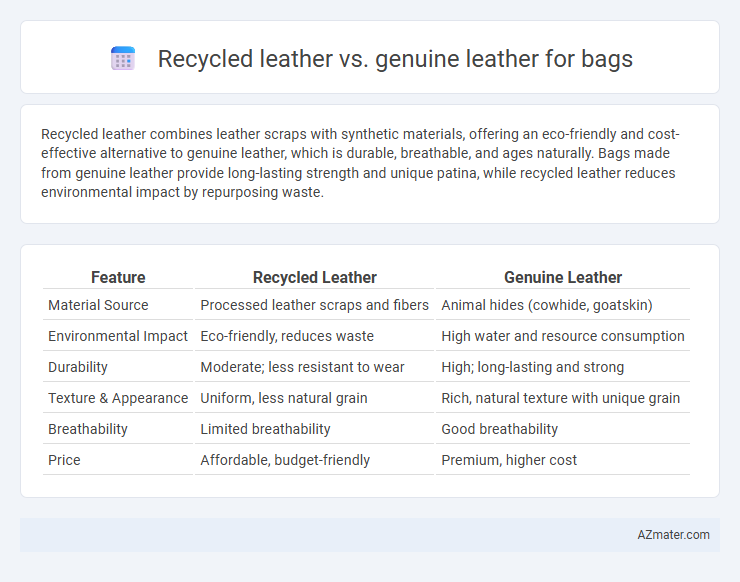Recycled leather combines leather scraps with synthetic materials, offering an eco-friendly and cost-effective alternative to genuine leather, which is durable, breathable, and ages naturally. Bags made from genuine leather provide long-lasting strength and unique patina, while recycled leather reduces environmental impact by repurposing waste.
Table of Comparison
| Feature | Recycled Leather | Genuine Leather |
|---|---|---|
| Material Source | Processed leather scraps and fibers | Animal hides (cowhide, goatskin) |
| Environmental Impact | Eco-friendly, reduces waste | High water and resource consumption |
| Durability | Moderate; less resistant to wear | High; long-lasting and strong |
| Texture & Appearance | Uniform, less natural grain | Rich, natural texture with unique grain |
| Breathability | Limited breathability | Good breathability |
| Price | Affordable, budget-friendly | Premium, higher cost |
Introduction to Recycled Leather and Genuine Leather
Recycled leather is made by combining shredded genuine leather scraps with bonding agents to create a sustainable and eco-friendly material, often used for bags to reduce waste and environmental impact. Genuine leather, derived from animal hides through a tanning process, is prized for its durability, natural texture, and premium quality in bags. Understanding the differences between recycled leather and genuine leather helps consumers make informed choices based on environmental concerns, cost, and desired product longevity.
What is Recycled Leather?
Recycled leather is made by shredding and reconstituting leftover leather scraps, combining them with a binding material to create a sustainable alternative to genuine leather. This process reduces waste and environmental impact by utilizing offcuts from leather production rather than relying solely on new raw hides. Bags made from recycled leather offer a durable, eco-friendly option that mimics the texture and appearance of genuine leather while promoting resource efficiency.
What is Genuine Leather?
Genuine leather is made from the natural hide of animals, typically cows, that undergoes tanning and finishing processes to enhance durability and appearance. This material is prized for its breathability, strength, and ability to develop a unique patina over time, making it a premium choice for high-quality bags. Genuine leather offers longevity and a luxurious feel that recycled leather, made from treated scrap leather or synthetic materials, often cannot fully replicate.
Production Process: Recycled vs. Genuine Leather
Recycled leather is produced by shredding and reconstituting leather scraps combined with polymers, significantly reducing waste and environmental impact during manufacturing. Genuine leather undergoes conventional tanning processes, often involving chemical treatments and water-intensive steps, which contribute to higher resource consumption and pollution. The production of recycled leather offers a sustainable alternative by repurposing existing materials, while genuine leather relies on raw animal hides with a more resource-intensive process.
Environmental Impact: Which is More Sustainable?
Recycled leather significantly reduces environmental impact by repurposing waste materials, lowering the demand for raw animal hides and minimizing water and chemical usage during production. Genuine leather involves extensive resource consumption, including water, land, and energy, and contributes to pollution through tanning processes that release harmful chemicals. Choosing recycled leather for bags supports sustainability efforts by reducing landfill waste and greenhouse gas emissions compared to the traditional leather industry.
Durability and Longevity
Recycled leather offers moderate durability, as it combines leather fibers with synthetic materials, making it less prone to cracking but more susceptible to wear over time compared to genuine leather. Genuine leather boasts superior longevity due to its natural strength and ability to develop a unique patina that enhances its appearance with age, often lasting decades with proper care. For bag durability, genuine leather remains the preferred choice for resilience and long-term use, while recycled leather provides an eco-friendly alternative with acceptable lifespan for moderate use.
Look and Feel: Texture and Aesthetics
Recycled leather offers a unique texture that combines natural leather fibers with synthetic materials, resulting in a slightly more uniform and less porous surface compared to genuine leather, which boasts a rich, natural grain and varied texture that improves with age. Genuine leather's aesthetics exhibit subtle imperfections and a soft, supple feel, providing a classic, luxurious appearance ideal for high-end bags. In contrast, recycled leather often presents a consistent finish with eco-friendly appeal, though it may lack the depth and softness found in authentic leather products.
Cost Comparison: Price Differences
Recycled leather bags typically cost 20-40% less than genuine leather bags due to the lower production expenses associated with repurposing leather scraps. Genuine leather requires extensive processing and higher quality raw materials, driving its price significantly higher, often ranging from $100 to $300 or more for premium bags. Budget-conscious consumers often prefer recycled leather for affordability without sacrificing the leather-like appearance.
Maintenance and Care Requirements
Recycled leather bags require less intensive maintenance compared to genuine leather, as they are more resistant to water and stains, making them easier to clean with a damp cloth. Genuine leather demands regular conditioning with specialized leather oils or creams to prevent drying and cracking, as well as protection from excessive moisture to maintain its durability and appearance. Both materials benefit from avoiding prolonged sun exposure and storing bags in breathable dust bags to extend their lifespan.
Which Leather is Right for Your Bag?
Recycled leather offers an eco-friendly alternative to genuine leather by utilizing leftover leather scraps bonded with polyurethane, making it more sustainable and affordable. Genuine leather, derived from animal hides, provides superior durability, natural texture, and a longer lifespan, ideal for high-quality, long-term use bags. Choosing the right leather depends on prioritizing environmental impact and cost-effectiveness versus durability and classic leather aesthetics.

Infographic: Recycled leather vs Genuine leather for Bag
 azmater.com
azmater.com